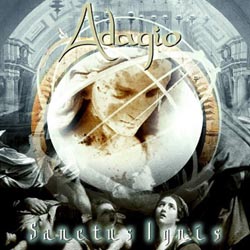
Steckbriefe| News| Tourdaten| Fotos| Fanclub| Bio|Links|
Sanctus Ignis erschien 2001

- französische Version ( NTS 3067802)
- europäische und amerikanische Version ( LMP 0105-031)
- japanische Version ( Avalon MICP 10241)
ADAGIO IN THEIR OWN WORDS:
Under the name of Adagio
and with an exciting mixture of fabulous guitar parts, the breathtaking
virtuosity of which is often reminiscent of Yngwie Malmsteen, classical
influence which show an unmistakeable preference for Bela Bartok, hints of
progressive bands such as Symphony X and tough-hitting metal arrangements, the
French musician Stephan Forte presents his audibly highly attractive debit album,
Sanctus Ignis. Stephan takes all forms of classical music into consideration,
from Baroque to contemporary composers.
Despite his positive disposition, he loves the dramatic, more melancholic
aspects of music and therefore prefers compositions written in minor keys. And
in addition he always manages to cleverly integrate oriental influences into his
compositions. An especially impressive example is his fascinating, instrumental
adaptation of the Led Zeppelin classic, ´Immigrant Song`, which is predestined
for such a stylistic, oriental metamorphosis as this.
It is no exaggeration to say that Sanctus Ignis is one of the most exciting and
interesting new releases of the year 2001 so far.
The album was produced by
Dennis Ward, the bass player of the German formation, Pink Cream 69. Ward had
already won a reputation of being an excellent producer for his own band's
albums and has also helped behind the scenes in the studio for Vanden Plas,
Axxis and DC Cooper.
The close ties between Pink Cream 69 and Stephan even go a step further: PC69
singer David Readman, who met Stephan at a concert in Summer 2000 has placed his
services at the disposal of Adagio. The beautiful ´Sanctus Ignis`, the
wonderful opener, ´Second Sight` and the monumental, 12 minute long ´Seven
Lands Of Sin` are excellent examples of how well Readman merges his unique voice
with the Frenchman's compositions. At first, Stephan was looking for a singer
similar to Goran Edman or Tomas Wikstrom but he was so impressed by Readman's
fabulous interpretation that he spontaneously asked the Briton for his support.
Readman and Stephan held long, intensive discussions and came to the conclusion
that they not only had music preferences but also personal things in common
Other guest musicians
called in by Stephan were the Elegy's Dutch drummer, Dirk Bruinenberg, as well
as his long-time friend, Franck Hermany as bass player.
For a while, it seemed as though Stephan's idea of having the Ukrainian keyboard
virtuoso, Vitalij Kulprij as keyboarder would come true. He travelled to
Philadelphia and recorded a demo with Kulprij in a small studio there. But
contractual problems prevented the recordings from being made public.Shelving
the plan to one day work on an instrumental album together with his Ukranian
friend, Stephan began looking for an alternative musician and then decided to
program most of the keyboard parts on Sanctus Ignis himself. For the complex
solo parts he was giben impressive assistance by Richard Anderson, keyboarder of
the Swedish band, Majestic.
All these musicians helped Stephan realize his visions of contemporary classic
metal with Sanctus Ignis, and each one of them left their personal mark on each
of the compositions
The 24 year old Frenchman
and guitarist can look back on almost twenty years of musical experience. When
he was five years old, he received his first guitar from his brother. The first
song he ever learned was by no means a standard guitar piece, but Alice Cooper's
"I'm Eighteen". Nine years later he discovered Yngwie Malmsteen.
Fascinated by the Scandinavian's virtuosity, Stephan knew from that moment on
that he wanted to become a professional musician. He formed his own band and
experimented with numerous styles, from Death Metal to Grind Core.
During this time he also took guitar lessons in order to learn every one of
Malmsteen's tricks of the trade.
When he was 18, he stopped taking lessons but practised up to ten hours a day on
his own which, one year later, won him a place at the distinguished CMCN Music
Academy in Nancy. On his return home to Montpellier he began extending his
musical horizons, occupying himself with classical musical (especially Baroque
and Mozart) as well as Jazz Fusion. During this period he also discovered
artistes such as Shawn Lane and Allan Holdworth. Stephan also occupied himself
with musical theory, and the diverse styles and harmonies of contemporary
composers.
His first demo, Visions, released in 1996, won him an endorsement deal with
several well known instrument manufacturers.
After opening for his idol, Yngwie Malmsteen in 1998 Stephan began looking at
the vocal side of music.
In September 1999 he sent eight original compositions to the French record
company, N.T.S., who offered him a lucrative contract practically by return
post, and who suggested the chance of forming his own band.
Which brings us to the present, and the release of his first album, Sanctus Ignis by his band, Adagio. It is a work that presents Stephan's great talents not only as a composer and instrumentalist, but also as an all-round musician. And it is one which gives just a hint of what fans of classical metal epics can look forward to in the years to come.